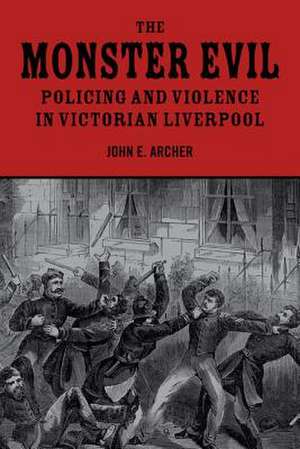The Monster Evil – Policing and Violence in Victorian Liverpool
Autor John E. Archeren Limba Engleză Hardback – 22 mar 2011
During the nineteenth century, Liverpool had a notorious reputation as a dangerous, violent, crime-ridden city. Yet were these fears justified? Or were they rather the sensational inventions of Victorian-era news?
The Monster Evil explores Liverpool’s history of violent crime and its policing by the then-new constabulary through the use of police records, local and national press, and contemporary accounts of the violence confronting constables on night patrol. The first significant account of nineteenth-century violence in a British city, this book covers the entire spectrum of violent crime, from murder to drunken assault, and sheds light on the role of the police in combating it.
Preț: 481.98 lei
Preț vechi: 940.12 lei
-49% Nou
Puncte Express: 723
Preț estimativ în valută:
92.23€ • 100.49$ • 77.71£
92.23€ • 100.49$ • 77.71£
Carte indisponibilă temporar
Doresc să fiu notificat când acest titlu va fi disponibil:
Se trimite...
Preluare comenzi: 021 569.72.76
Specificații
ISBN-13: 9781846316579
ISBN-10: 184631657X
Pagini: 288
Ilustrații: 5 halftones, 3 maps
Dimensiuni: 164 x 242 x 22 mm
Greutate: 0.61 kg
Editura: Liverpool University Press
ISBN-10: 184631657X
Pagini: 288
Ilustrații: 5 halftones, 3 maps
Dimensiuni: 164 x 242 x 22 mm
Greutate: 0.61 kg
Editura: Liverpool University Press
Notă biografică
John E. Archer is an honorary research fellow at Edge Hill University in the United Kingdom and a fellow of the Royal Historical Society.
Cuprins
List of illustrations, figures and tables
Preface
Acknowledgements
List of abbreviations
Street map of Liverpool in the 1880s
Part I: Liverpool
1. Liverpool and the taint of criminality
2. Liverpool: “The most immoral of all immoral places’
Part II: Policing the borough
3. ‘An army to check barbarism’: the policing of Liverpool
4. The community and the police: evidence, lies and violence
Part III: Violent crime in Liverpool
5. The fighting Irish
6. The fist, the boot and the knife: male-on-male violence
7. The Liverpool cornermen, gangs and garroting
8. Female savages and tippling viragoes: violent women
9. Women as victims of domestic and sexual violence
10. ‘A constant state of strife’: family violence
11. ‘Boy brigands’ and ‘young savages’: juvenile criminals and their young victims
12. ‘A most unmerciful beating’: adult violence to children
13. A conclusion. ‘Giving a dog a bad name’: Liverpool and its criminal reputation in the nineteenth century
Appendix: Saturday night and Sunday morning: Hugh Shimmin’s account of the Rosehill night shift
Notes
Bibliography
General Index
Index of people
Index of street names and places
Preface
Acknowledgements
List of abbreviations
Street map of Liverpool in the 1880s
Part I: Liverpool
1. Liverpool and the taint of criminality
2. Liverpool: “The most immoral of all immoral places’
Part II: Policing the borough
3. ‘An army to check barbarism’: the policing of Liverpool
4. The community and the police: evidence, lies and violence
Part III: Violent crime in Liverpool
5. The fighting Irish
6. The fist, the boot and the knife: male-on-male violence
7. The Liverpool cornermen, gangs and garroting
8. Female savages and tippling viragoes: violent women
9. Women as victims of domestic and sexual violence
10. ‘A constant state of strife’: family violence
11. ‘Boy brigands’ and ‘young savages’: juvenile criminals and their young victims
12. ‘A most unmerciful beating’: adult violence to children
13. A conclusion. ‘Giving a dog a bad name’: Liverpool and its criminal reputation in the nineteenth century
Appendix: Saturday night and Sunday morning: Hugh Shimmin’s account of the Rosehill night shift
Notes
Bibliography
General Index
Index of people
Index of street names and places
Recenzii
“Victorian Liverpool had an unenviable reputation for violence. This book sets out to assess both the scale and variety of Liverpool’s violence, and the means by which it was policed. Exhaustively researched and persuasively argued, it adds significantly to the debates about the history of criminal violence and of policing.”
